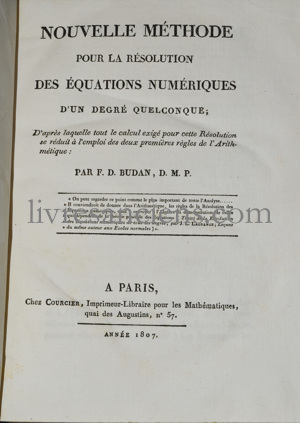

BUDAN, Nouvelle méthode pour la résolution, 1807

BUDAN, Ferdinand.
Nouvelle méthode pour la résolution des équations numériques.
Paris, Courcier, 1807.
Deux ouvrages reliés en un volume in quarto (246x202 mm), [Budan] : (8)-86-(2) pages / [Bezout] : (4)-xxviii-471 pages. reliure : Pleine basane de l'époque, dos lisse orné et doré. Reliure légèrement frottée.

Édition originale.
Ouvrage dans lequel Budan énonce ce qui est aujourd'hui connu sous le nom de théorème de Budan-Fourier.
À la suite, on trouve relié :
BEZOUT, Théorie générale des équations algébriques, Paris, Ph.-D. Pierres, 1779.
(4)-xxviii-471 pages.
Édition originale.
Bezout y traite de la résolution des équations à n inconnues par élimination.
références: I. Budan : DSB [II p.573 :"Budan is known in the theory of equations as one of the independent discoverers of the rule of Budan and Fourier, which gives necessary conditions for a polynomial equation to have n real roots between two given real numbers. He announced his discovery of the rule and described its use (...) and published the paper with explanatory notes, as 'Nouvelle méthode pour la résolution des équations numériques', in 1807. (...) The need for such a rule as his was suggested to Budan by Lagrange's 'Traite de la resolution des equations numeriques' (1767). . . . Budan's goal was to solve Lagrange's problem - between which real numbers do real roots lie? - purely by means of elementary arithmetic. Accordingly, the chief concern of Budan's 'Nouvelle méthode' was to give the reader a mechanical process for calculating the coefficients of the transformed equation in (x - p). He did not appeal to the theory of finite differences or to the calculus for these coefficients, preferring to give them 'by means of simple additions and subtractions.' (...) Budan's rule remains the most convenient for computation"].
II. Bezout : DSB [II pp.111-5 : "It was not until 1779 that Bezout published his Théorie des équations algébriques, his major work on elimination theory. Its best-known achievement is the statement and proof of Bezout's theorem : 'The degree of the final equation resulting from any number of complete equations in the same number of unknowns, and of any degrees, is equal to the product of the degrees of the equations'... Bezout's work on resultants stimulated many investigations in the modern theory of elimination, including Cauchy's refinements of elimination procedure and Sylvester's resultants and inertia forms. Bezout's theorem is crucial to the study of the intersection of manifolds in algebraic geometry...".].
Prix : 1500 €












